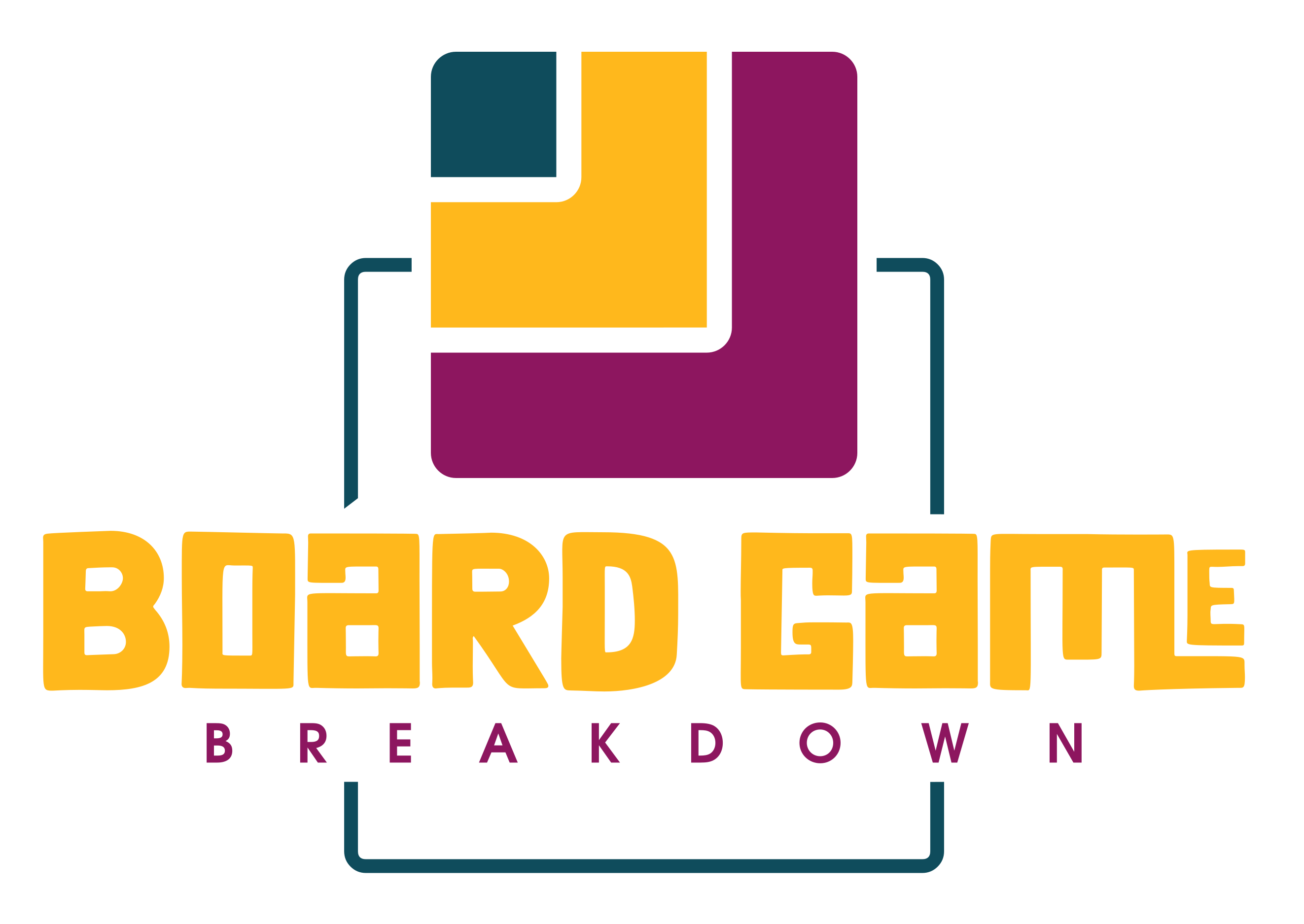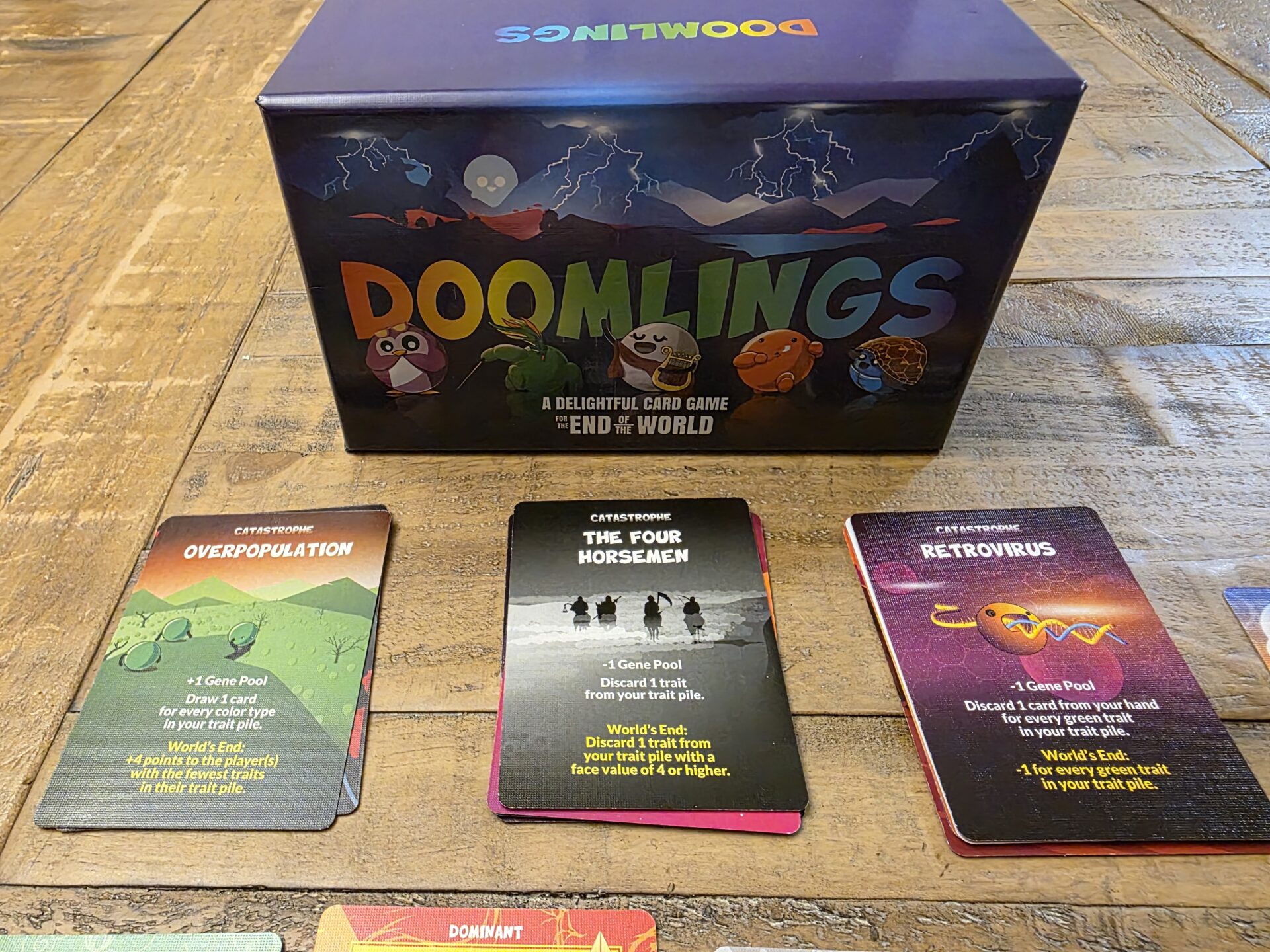
Name: Doomlings
Year of Release: 2022
Player Count: 2 – 6
Playing Time: 20 – 45 Minutes
Designer: Justus and Andrew Meyer
Publisher: Doomlings LLC
Primary Mechanisms: Hand Management, Take That, Set Collection, Events
Weight (According to BGG.com): 1.71
Overview
In the interest of transparency, I received a complimentary copy of Doomlings for review purposes. This did not influence my assessment, and the opinions expressed here are my honest and unbiased reflections on the game.
Over time, my tastes for things have changed. Whether that be in board games, music, or food, what I enjoy has evolved in different ways as I’ve grown. Some of this can be attributed to changes in my personal outlook and perspective on life, but sometimes my tastes have changed strictly out of necessity. Having three children, a full-time job, and generally, just a lot of things going on in life, has made getting a large gaming group together for a night of board games almost impossible. And with it, the ability to play a lot of “party games” has gone out the window. Note: I’m using “party games” as a catch-all term for games that can play at a higher play count and only need minimal direction to start playing.
Enter Doomlings: a hand-management and “take that” card game that can scale up to six players, enabling players to jump right in within a few minutes of opening the box, and has some strategic depth to it. Add in the fact that even my 9-year-old can play it, and I’ve found a game that gives us that “party” feel, even at three or four players, letting me skip the hassle of trying to organize board game night with a bunch of other 40-year-old-parents. Read on to see what Doomlings is all about.
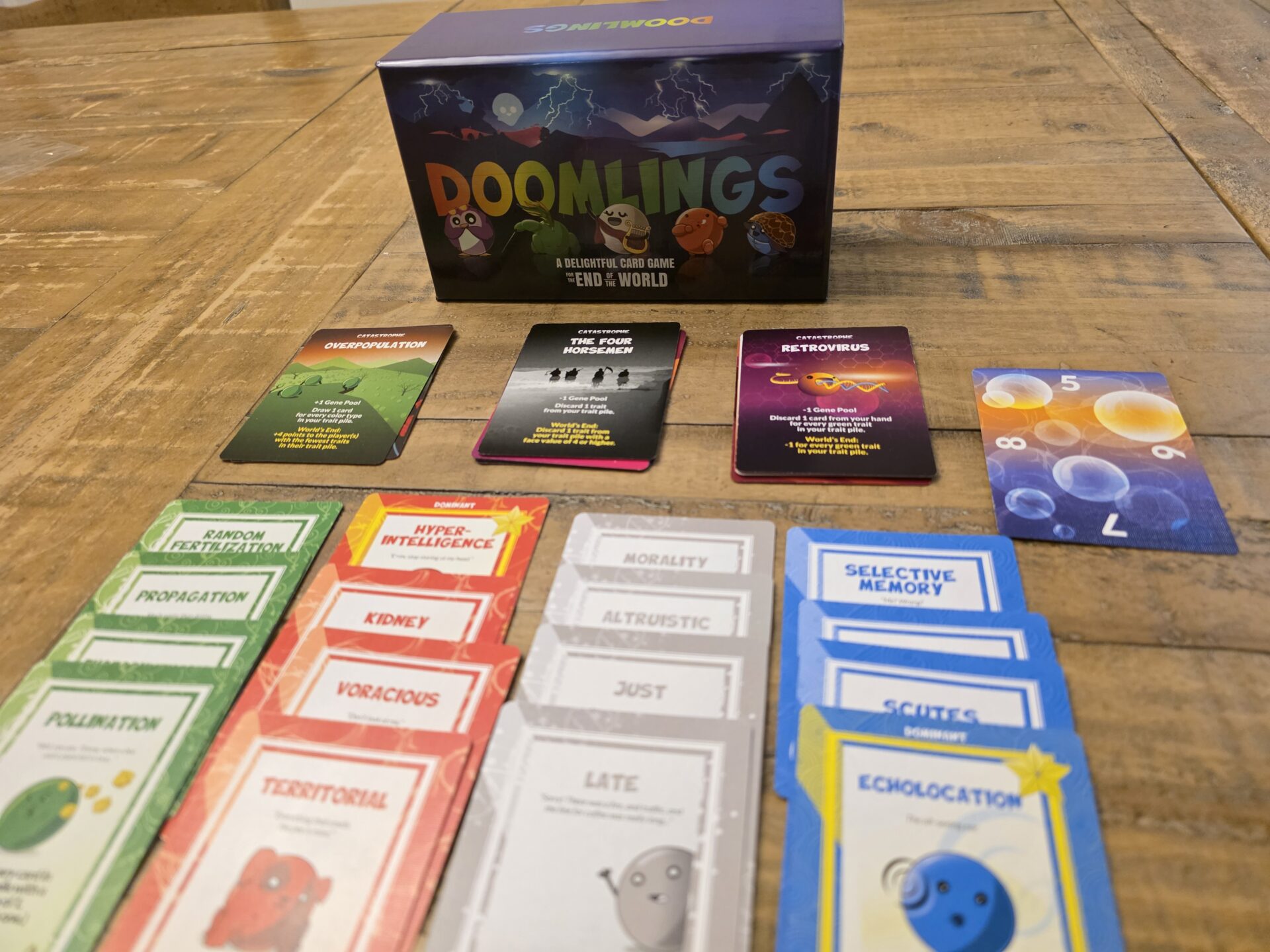
Rulebook & Components
The rulebook, despite its compact size, provides a comprehensive overview of the game’s mechanics. However, certain card interactions, such as the Vampirism Card, could benefit from clearer rulebook clarification to minimize potential player disputes. The inclusion of a QR code for tutorials and scoring tools is a helpful addition that I hope more game designers include.
Doomlings is a card-driven experience, and its components excel in their visual appeal. The game features two primary card types: Ages and Traits. The Age Deck showcases vibrant illustrations by Justus Meyer, depicting both serene landscapes and dramatic Catastrophe events, balancing whimsical charm with a touch of apocalyptic humor. The Trait Cards, divided into color-coded suits, feature unique, expressive spherical characters engaging in humorous actions, accompanied by witty flavor text.
A few of my favorites are the Doting Card which shows a spherical family, with one of the larger sphere’s holding a baking tray. The flavor text states, “OK! These are the last of the cookies. Unless you want more. I’ll make more.” Any parent reading this can probably relate. Another card, called Persuasive, displays a purple sphere at a podium, pointing and shouting at a gathering of other purple spheres with the text, “Change your mind or I will yell louder!” It’s great that every card is different, making it a joy to look through your hand as you play. There are some other elements to the cards, but we’ll discuss that during the gameplay section.
While the Gene Pool Cards, used for tracking hand limits, serve their function, their simple design could be enhanced for improved usability. A more robust tracking mechanism, such as embedded dials, would mitigate the issue of accidentally hitting them during gameplay. However, the current design is functional and likely a cost-effective choice, contributing to the game’s accessible price point.
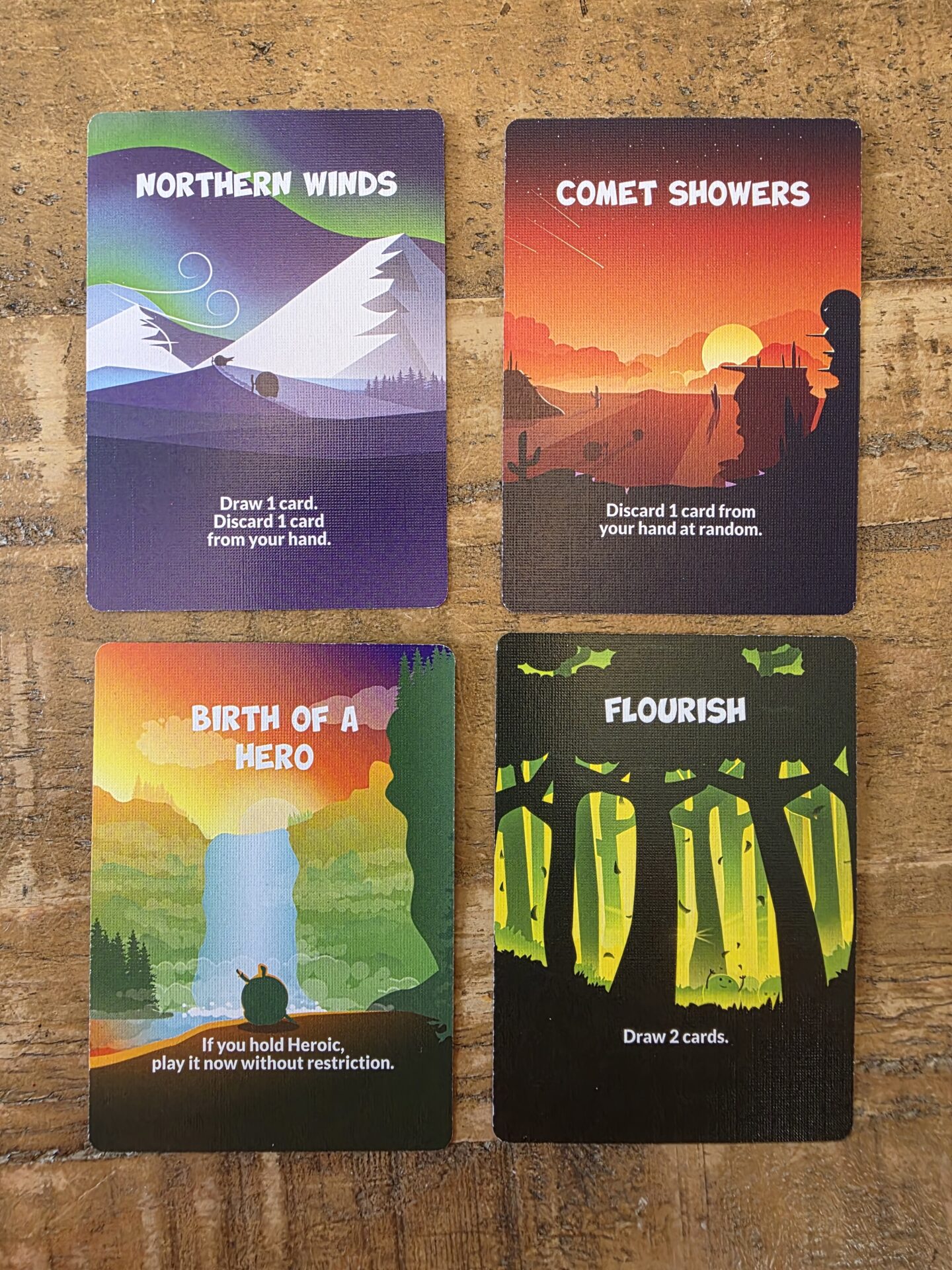
Setup & Gameplay
As with many card games, setup isn’t much more than dealing out cards, but Doomlings does have the added need to set up the Ages Deck. This is simple enough in someone first separates the Catastrophe Cards from the regular Age Cards. Then they deal out three piles of three Age Cards, face down on the table. Next, randomly put a single Catastrophe Card into each of the three piles. Then the player shuffles up each pile, individually, and then stacks them on top of each to form the Age Deck. By doing this, the Catastrophe Cards are randomly spread throughout the deck, though two are still able to come out back-to-back, you’d be sure that the third isn’t going to show up for at least four more rounds. The last thing to set up the Ages Deck is to put the Birth of Life Card on top so that it is always the first card flipped over. Each player takes their Gene Pool Card and turns it so the number five is facing up. Then five Trait Cards are dealt to each player, and the game is ready to go.
A round commences with the active player revealing an Age Card, triggering its associated effect. Players then take turns placing a Trait card into their tableau (Trait Pile), which functions as a scoring and effect-generating area. Honestly, the term Trait Pile has been fairly confusing to the people I’ve taught it to because they are looking for a literal stack of cards, not rows of cards, so I kind of wish this had been given a more descriptive name.
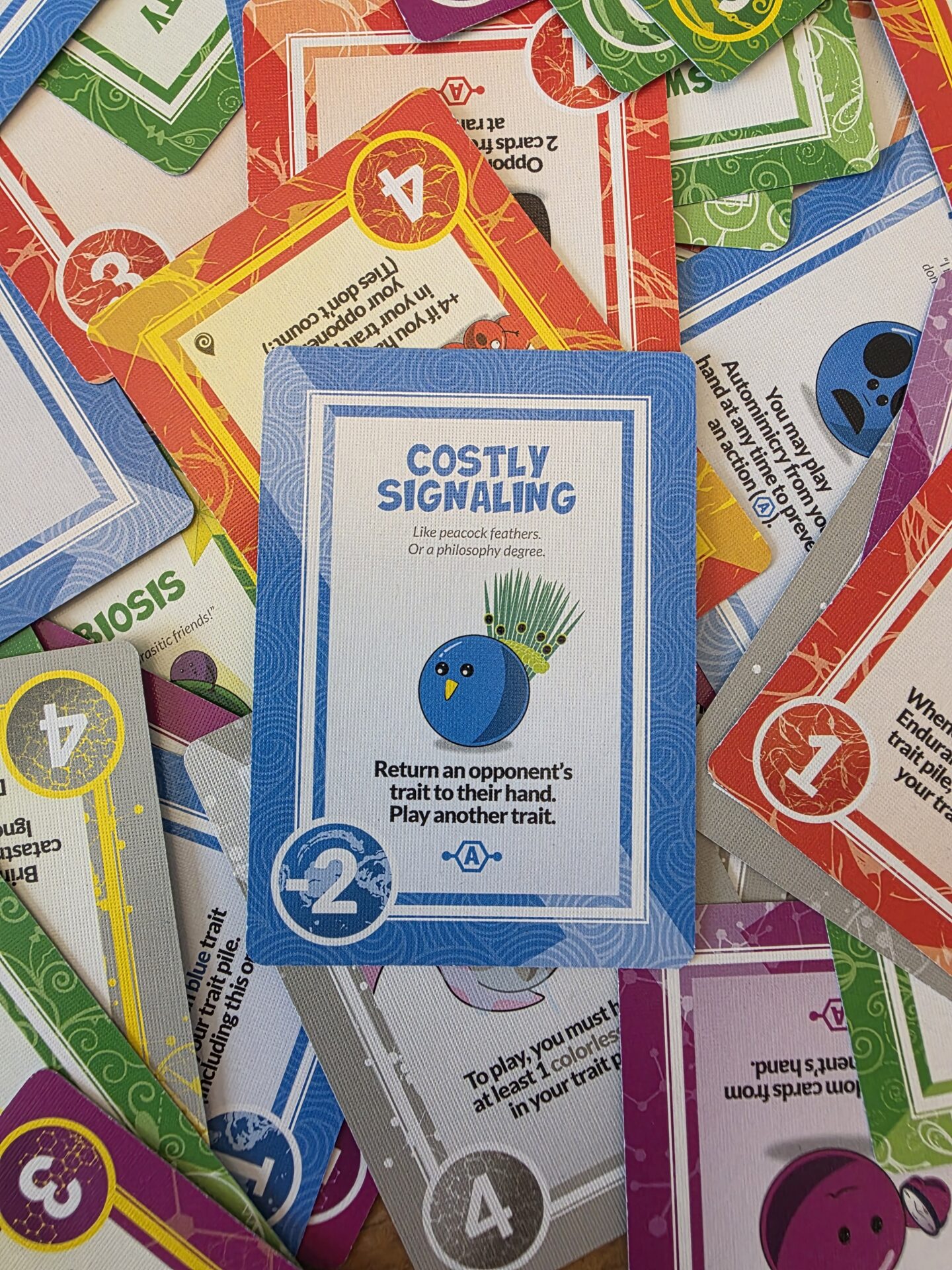
Trait Cards feature point values, variable scoring (Compass Star Icon), or negative values balanced by powerful effects. Actions are triggered upon playing a card from hand, such as the blue card, Flight, allowing the player to “swap hands with an opponent,” possibly throwing a real wrench into someone’s plans. Cards may have Effects rather than Actions. Effects remain active within the tableau until they are discarded. Lastly there are Dominant Traits, cards immune to manipulation, offering significant scoring potential but are limited to two per player.
After playing a Trait, players Stabilize their hand by drawing or discarding to match their Gene Pool value. You’ll remember that this starts the game at five but can be increased or decreased by playing certain Traits or even flipping over certain Age Cards. The next round starts with the revelation of the next Age card. If it is another non-Catastrophe Card, the next round continues as the earlier rounds did. If it is a Catastrophe Card, the first player designation moves clockwise to the next player and then the round continues as normal.
The hiccup is when the Third Catastrophe Card is unveiled. At this point, the end of the world is upon the Doomlings! Players still follow the directions on the Catastrophe Card, but also follow the Yellow Text printed on the bottom of the card. After doing so, players will trigger all of their World’s End Effects and then add up all of the printed values on their cards to see who has the most points in order to win.

General Thoughts
Doomlings incorporates a “take that” mechanic, which, while present, is not overly disruptive. The game’s diverse card pool ensures that the level of player interaction varies, preventing it from becoming overly aggressive. I was afraid it would be similar to Munchkins (which I loathe) but was delighted to find out it wasn’t.
The color-coded Trait cards encourage set collection, adding a layer of strategic depth that one might not find in other “party games.” The game’s scalability and quick setup make it suitable for various player counts and time constraints so I think this game can fit into a variety of player’s collections.
Its humorous artwork, engaging gameplay, and scalability make it an ideal choice for families and casual gamers seeking a lighthearted and enjoyable experience. While minor rulebook clarifications and Gene Pool card design improvements could enhance the overall experience, Doomlings delivers a satisfying and entertaining card game. If you seek a game that blends humor, strategy, and accessibility, Doomlings is a worthy contender.
Rating
Ratings are based on 5 main criteria: rulebook, setup, components, art & graphic design, and gameplay. The first 4 criteria are rated 1 to 5 and the gameplay is rated 1 to 10. These scores culminate in an “overall satisfaction” score that is rated from 1 to 10. If the reviewed game has both a solo and multiplayer mode, I have assigned scores separately to give context to which mode we enjoy more.
